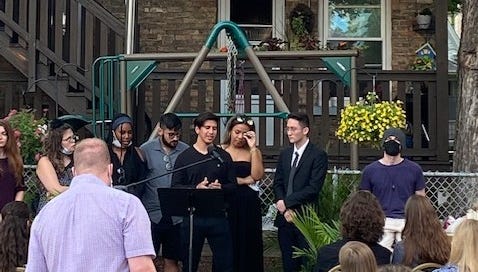Most of the people gathered for a memorial service in the parking lot of the Edgewater Baptist Church seemed stunned.
They had received a shock that was outside their experience. It’s outside the experience of most people.
Gary Tinder, 20, a promising college student most of the attendees knew well, had been gunned down on Father’s Day on a very quiet block in a very quiet neighborhood in West Rogers Park. He was walking home from work.
No matter what the reason turns out to be, the crime is likely to have elements of randomness, and most everybody in the parking lot knew that.
But most white people are not used to random murder. They don’t understand it. No one should. I don’t.
I knew a lot of the people in the parking lot. My daughter went to elementary school for years with Gary at tiny St. Philip Lutheran School, a few blocks from our home in the north end of Lincoln Square. Gary attended largely because his mother taught there. They actually lived in Skokie.
My daughter’s mother taught at the local Chicago Public School, which didn’t have an after-school program. We needed a nearby school that had one, and St. Philip was it. So we sent our kid to a school with a graduating class of a dozen or so that was somewhat detached from reality.
Even though a few of the students were black, and there wasn’t much money in most of the parents’ pockets, almost everything that makes being white in Chicago a weird privileged class was magnified in the little school. Few minority education classes, no real diversity, no special ed.
At the memorial service, one after another, kids and adults got up to talk about Gary, who seemed to have turned out very nice and very smart. He was one of those young people who tried to do everything right, and usually succeeded, but he wasn’t a jerk about it. He was a helpful person, and he wasn’t a jerk about that, either.
His was the kind of future that people eagerly anticipate, because whatever he became, we all thought it would be cool.
Had to be.
The people at the microphone almost all said something to the effect that they would see Gary again when they got to Heaven. That’s comforting and positive. It may be the only way many people have of reconciling such an untimely death.
But something was missing.
If you expect me to tell you that there was screaming, rending of garments and promises to straighten out ourselves and our society so that such things might stop happening, you’ll be disappointed.
That’s for black people and other folks we more often see wailing over the children disappeared from their homes, situated in places where the price of life is significantly cheaper. They’re often more angry than shocked.
Conversely, when something like this happens to white people, we tend to look at it as an anomaly. This will be unlikely to intrude on our world again.
That’s because the advantages that many white people have give us much better odds of survival.
We typically get to live on safer streets, and have to scramble less for the rent. When we’re at work, we’re usually not the first people suspected when something gets stolen.
Gary’s father died when he was an adolescent, which made things uphill for him at times. But he also had a private school education and a sought-after internship, a safe place to live and a free ride to a good college.
But his world, truly, is the same world where all the other dead kids lived.
There’s no difference between Gary’s death and the deaths of the 13 other people who went down in the hail of gunfire that was Chicago’s Fathers Day weekend. Bullets don’t care what you look like or where you live. They don’t care if you’ve got a 4.0 at De Paul.
After all, school shootings almost exclusively occur in affluent, white neighborhoods. Black kids get shot outside school. To a grieving parent, there’s not much difference.
So far, most of us probably don’t have a child who’s lost a friend to murder. One day, many more of us may be in that boat, no matter how incredibly unfair that feels. It feels unfair to me, that’s for sure.
But it’s not something that is attacking us from beyond our ability to understand. We are familiar with violence and cruelty. It’s as close as our TV sets and smartphones, as intimate to us as our neighbors and friends and families.
Young people die, killed by other young people. Maybe it’s time we stop thinking about the deaths of some of them differently from others.
The death of every person is a diminishment of ourselves, isn’t it?
But not when we define ourselves by our colors and our incomes, our religions and our politics. We often live separated from people who look just a bit different. And we try to split the pie according to our power and our prejudices.
It’s no wonder we don’t get along. No wonder violent death is a part of life. We can’t ask our young generations to respect life if we don’t respect each other.
My daughter wound up attending Senn High School, a Chicago public school that’s 97% diverse, which means 3% white. That was nothing like my high school experience.
I got an education mostly with students who looked like me, and who disdained those who didn’t. She got a four-year education in how to live with other people.
That’s the curriculum we all need if we’re to survive.




Yes, to a growing number of us black lives do.